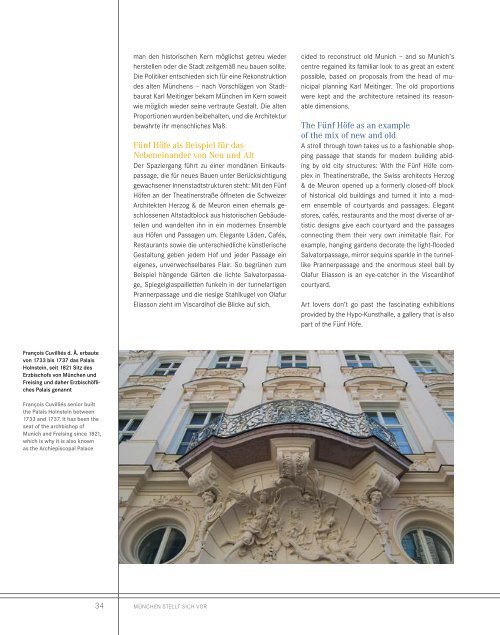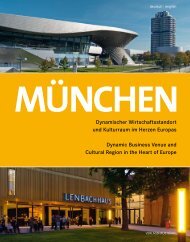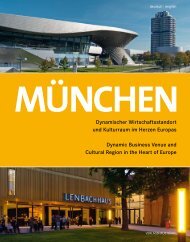Buch_Muenchen
You also want an ePaper? Increase the reach of your titles
YUMPU automatically turns print PDFs into web optimized ePapers that Google loves.
man den historischen Kern möglichst getreu wieder<br />
herstellen oder die Stadt zeitgemäß neu bauen sollte.<br />
Die Politiker entschieden sich für eine Rekonstruktion<br />
des alten Münchens – nach Vorschlägen von Stadtbaurat<br />
Karl Meitinger bekam München im Kern soweit<br />
wie möglich wieder seine vertraute Gestalt. Die alten<br />
Proportionen wurden beibehalten, und die Architektur<br />
bewahrte ihr menschliches Maß.<br />
Fünf Höfe als Beispiel für das<br />
Nebeneinander von Neu und Alt<br />
Der Spaziergang führt zu einer mondänen Einkaufspassage,<br />
die für neues Bauen unter Berücksichtigung<br />
gewachsener Innenstadtstrukturen steht: Mit den Fünf<br />
Höfen an der Theatinerstraße öffneten die Schweizer<br />
Architekten Herzog & de Meuron einen ehemals geschlossenen<br />
Altstadtblock aus historischen Gebäudeteilen<br />
und wandelten ihn in ein modernes Ensemble<br />
aus Höfen und Passagen um. Elegante Läden, Cafés,<br />
Restaurants sowie die unterschiedliche künstlerische<br />
Gestaltung geben jedem Hof und jeder Passage ein<br />
eigenes, unverwechselbares Flair. So begrünen zum<br />
Beispiel hängende Gärten die lichte Salvatorpassage,<br />
Spiegelglaspailletten funkeln in der tunnelartigen<br />
Prannerpassage und die riesige Stahlkugel von Olafur<br />
Eliasson zieht im Viscardihof die Blicke auf sich.<br />
cided to reconstruct old Munich – and so Munich’s<br />
centre regained its familiar look to as great an extent<br />
possible, based on proposals from the head of municipal<br />
planning Karl Meitinger. The old proportions<br />
were kept and the architecture retained its reasonable<br />
dimensions.<br />
The Fünf Höfe as an example<br />
of the mix of new and old<br />
A stroll through town takes us to a fashionable shopping<br />
passage that stands for modern building abiding<br />
by old city structures: With the Fünf Höfe complex<br />
in Theatinerstraße, the Swiss architects Herzog<br />
& de Meuron opened up a formerly closed-off block<br />
of historical old buildings and turned it into a modern<br />
ensemble of courtyards and passages. Elegant<br />
stores, cafés, restaurants and the most diverse of artistic<br />
designs give each courtyard and the passages<br />
connecting them their very own inimitable flair. For<br />
example, hanging gardens decorate the light-flooded<br />
Salvatorpassage, mirror sequins sparkle in the tunnellike<br />
Prannerpassage and the enormous steel ball by<br />
Olafur Eliasson is an eye-catcher in the Viscardihof<br />
courtyard.<br />
Art lovers don’t go past the fascinating exhibitions<br />
provided by the Hypo-Kunsthalle, a gallery that is also<br />
part of the Fünf Höfe.<br />
François Cuvilliés d. Ä. erbaute<br />
von 1733 bis 1737 das Palais<br />
Holnstein, seit 1821 Sitz des<br />
Erzbischofs von München und<br />
Freising und daher Erzbischöfliches<br />
Palais genannt<br />
François Cuvilliés senior built<br />
the Palais Holnstein between<br />
1733 and 1737. It has been the<br />
seat of the archbishop of<br />
Munich and Freising since 1821,<br />
which is why it is also known<br />
as the Archiepiscopal Palace<br />
34<br />
München stellt sich vor




